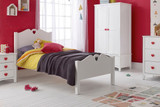The Ultimate Guide to Choosing the Perfect Mattress for Your Child’s Bed
As parents, we all want the best for our children, and that includes ensuring they get a good night’s sleep. One of the most important factors in achieving this is choosing the right mattress for their bed. With so many options available, it can be overwhelming to know where to start. In this ultimate guide, we’ll walk you through the process of selecting the perfect mattress for your child’s bed, taking into consideration their age, sleeping habits, and any specific needs they may have.
Table of Contents
- Why a Good Mattress Matters for Your Child
- Key Factors to Consider When Choosing a Mattress
- Popular Types of Mattresses for Children
- Understanding Mattress Sizes and Dimensions
- Expert Tips for Mattress Shopping
- How to Care for Your Child’s Mattress
1. Why a Good Mattress Matters for Your Child
A good mattress is essential for your child’s overall health and well-being. It provides the necessary support for their growing bodies, ensuring proper spinal alignment and reducing the risk of developing back problems later in life. Additionally, a comfortable mattress can improve sleep quality, which is crucial for their physical, cognitive, and emotional development.
2. Key Factors to Consider When Choosing a Mattress
When selecting a mattress for your child, there are several factors to consider:
- Age: The mattress should be appropriate for your child’s age and developmental stage. For example, toddlers may need a firmer mattress to support their growing bodies, while older children and teenagers may prefer a softer, more comfortable surface.
- Sleeping habits: Consider your child’s sleeping position and habits. Some children sleep on their side, while others prefer their back or stomach. Choose a mattress that provides adequate support and comfort for their preferred sleeping position.
- Allergies and sensitivities: If your child has allergies or sensitivities, opt for a hypoallergenic mattress made from natural materials, such as latex or organic cotton.
- Durability: Children can be tough on their mattresses, so look for one that is built to last and can withstand years of use.
3. Popular Types of Mattresses for Children
There are several types of mattresses available for children, each with its own set of benefits:
- Innerspring mattresses: These traditional mattresses feature a system of metal coils that provide support and bounce. They are generally more affordable and offer good support for growing children.
- Memory foam mattresses: These mattresses contour to your child’s body, providing excellent support and pressure relief. They are great for children who prefer a softer sleeping surface or have specific pressure points that need extra cushioning.
- Latex mattresses: Made from natural rubber, latex mattresses are hypoallergenic and resistant to dust mites and mold. They offer a combination of support and comfort, making them suitable for children of all ages.
- Hybrid mattresses: These mattresses combine the best features of innerspring and foam mattresses, offering both support and comfort. They are ideal for children who need a more luxurious sleeping experience.
4. Understanding Mattress Sizes and Dimensions
When choosing a mattress for your child’s bed, it’s essential to select the right size. Here are the most common mattress sizes for children:
- Toddler mattresses: Measuring 70 x 140 cm, these mattresses are designed for toddler beds and are suitable for children aged 1-2 years.
- Single mattresses: Measuring 90 x 190 cm, single mattresses are suitable for children aged 3-12 years and fit standard single beds.
- Small double mattresses: Measuring 120 x 190 cm, these mattresses are ideal for teenagers or children who need more space to sleep comfortably.
- Trundle mattresses: These slim mattresses are designed to fit under a bed and are perfect for sleepovers.
5. Expert Tips for Mattress Shopping
When shopping for a mattress, keep the following tips in mind:
- Test the mattress: If possible, have your child lie down on the mattress to ensure it provides the right level of support and comfort.
- Read reviews: Look for reviews from other parents who have purchased the same mattress to get an idea of its quality and performance.
- Check the warranty: A good mattress should come with a warranty that covers any defects or issues that may arise over time.
- Consider a mattress protector: A waterproof mattress protector can help extend the life of your child’s mattress and protect it from spills and accidents.
6. How to Care for Your Child’s Mattress
To ensure your child’s mattress lasts as long as possible, follow these care tips:
- Rotate the mattress regularly: Rotating the mattress every few months can help prevent sagging and uneven wear.
- Clean spills immediately: If your child spills something on the mattress, clean it up right away to prevent stains and damage.
- Use a mattress protector: A mattress protector can help keep the mattress clean and free from allergens, dust mites, and other irritants.
- Replace the mattress when necessary: While a good-quality mattress can last for many years, it’s essential to replace it when it no longer provides adequate support and comfort.
Conclusion
Choosing the perfect mattress for your child’s bed is an important decision that can impact their sleep quality and overall health. By considering factors such as age, sleeping habits, and mattress type, you can find the ideal mattress to support your child’s growth and development. Don’t forget to care for the mattress properly to ensure it lasts for years to come. Explore our range of children’s mattresses to find the perfect fit for your child’s bed.
Recent Posts
-
Our Top 5 White Single Beds for Kids
One of the most popular types of childrens single bed is a classic white single bed. Offerin
-
Why Magical Mid Sleeper Beds are a Kid's Dream
When it comes to creating a bedroom for your child, you want it to be a place that inspires their im







